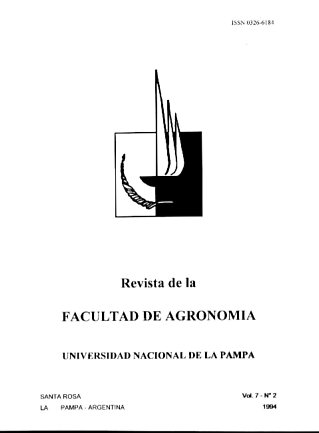Cumulative growth of Melilotus alba Medikus. III. Forage production and morphological composition
Keywords:
Melilotus alba Medikus, annual white sweetclover, DM production, leat %.Abstract
The present study was carried out in order to evaluate forage DM accumulation of annual white sweet clover (Melilotus alba Medikus). Evaluation started when plants reached 16.5 cm in height (vegetative stage) and continued until the fructification atage. Eight treatments (sampling dates) were arrangad in a randomized complete block experimental design with three replications. Total removal of forage was done at each sampling date. Plant height, phonological Stata, forage yield, and stem:leaf:flower ratio were estimated. Mathematical models representing the relationships between the independent variable "number of days from first cut" and the dependent variables "dry matter (DM) production" and "Ieaf %" were developed. In each case the correspondent R2 was calculated. White sweetclover had a typical spring growth. The highest cumulative DM yield was observed at fructification stage (17,000 kg DM/ha). Leaf % decreased throughout the growing season from 73.4 % (July 2) to 3.4 % (January 1). Growth rate (kg DM/ha/day) was not correlated with rainfall or average temperature. Cumulative DM yield had a positive correlation with plant height, average temperature and cumulative rainfall.
Downloads
References
BERNARDON, A. E., 1974. Recursos forrajeros de la región centro oeste de la Rep. Argentina. Prod. Animal 5 Tomo 1: 19-25.
CANGIANO, C. A. y MOMBELLI, J. C., 1975. Curva de crecimiento del trébol de olor blanco anual (Melilotus alba Medikus). Rev. lnv, Agrop. (lNTA) Serie 2 (Biología y Prod. Veg.) Vol. XII n° 3: 77-96.
ECHEVERRIA, J. C. y KALL, G. F., 1990. Las lluvias en Villa Mercedes (S.L.). Centro Reg. La Pampa-San Luis. Inf. Técnica n° 113: 16 pp.
GODlO, L.; VENECIANO, J. H. Y PRIVITELLO, L. J. M., 1988. Curva de crecimiento, productividad y calidad del trébol de olor blanco anual (Melilotus alba Medikus). 11 Jornadas de divulgación de la investigación de la Fac. de Ing. y Adm. (U.N.S.l.).Resúmenes: 18-19.
PICASSO, R. A .• 1992. El mercado de las semillas forrajeras. Primeras jornadas nacionales de producción de semillas y mejoramiento genético de especies forrajeras (Fac. Agr.- U.B. A.). Conferencias y resúmenes: 3-6.
SEVILLA, G. H., 1989. Curvas de producción de achicoria (Cichorium intybus L.) fertilizada. Rev. Arg. Prod. Anim. Vol. 9 n° 1: 69-76.
SPADA, M. del C. y CANGIANO, C. A., 1991. El uso del disco en la estimación de la fitomasa aérea: una comparación con otros métodos. Rev. Arg. Prod. Anim. Vol. 11 n? 1: 19-27.
SPADA, M. del C. y CANGIANO. C. A., 1992. Evaluación de un capacitómetro para estimar la fitomasa aérea. Rev. Arg. Prod. Animal Vol. 12 n° 1: 33-38.
VENECIANO, J. H.; SAGER, R. y BERTON, J. A., 1993. Producción anual y estacional de forraje en S. pellitum (Hackell L. Parodi. Rev. Arg. Prado Animal. (En prensa).
Downloads
Published
Issue
Section
License
La Editorial de la Universidad Nacional de La Pampa (EdUNLPam) exigirá a los/as autores/as la firma del siguiente documento:
La EdUNLPam lleva a cabo la publicación del artículo: (Título del Artículo) en SEMIÁRIDA Rev.Fac.Agron UNLPam ISSN 2362-4337 (impresa) ISSN 2408-4077 (en línea), del cual el/los abajo firmantes son autores de una o más partes. En el mismo acto, el/los autores entregan exclusivamente a la EdUNLPam todos sus derechos protegidos por las leyes de propiedad intelectual que rigen en la Argentina para reproducir, publicar, editar, fijar, comunicar y transmitir públicamente en cualquier formato o medio impreso o electrónico, inclusive internet, el artículo enviado a publicación e incluirlo en índices o bases de datos nacionales e internacionales. A cambio, la EdUNLPam entrega a los autores la autorización para la publicación o reimpresión con ines académicos y educativos en cualquier libro o medio de divulgación, con la sola obligación de citar el artículo original publicado en la EdUNLPam. Cada autor acuerda en que el material provisto a la EdUNLPam es un trabajo original, que no ha sido impreso o publicado en cualquier otro medio con anterioridad y que no vulnera derechos de terceros. El Primer autor tendrá la posibilidad de leer y corregir el artículo ya editado como “prueba de galera”, pero si el autor no devolviera esas correcciones de la prueba de galera dentro del tiempo especificado, el proceso de producción y publicación podrá proseguir sin la aprobación del autor. El/los autor/es no recibirán compensación monetaria de la EdUNLPam por el uso del material contenido en este artículo y asumen la responsabilidad de las opiniones vertidas en él.






.png)



22.png)



.jpg)




.jpg)
